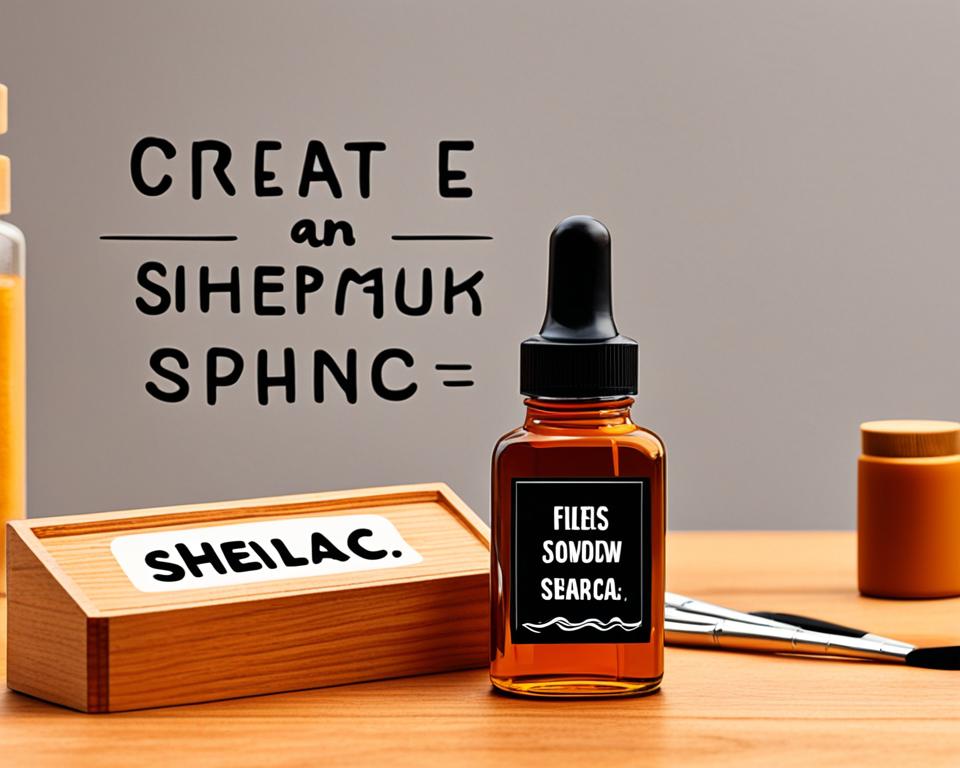Shellac is an all-natural wood finish that has been used in furniture making for centuries. It is made from the secretion of Lac insects found in India and Pakistan. Shellac creates a thin protective layer over wood, similar to lacquer or polyurethane. It comes in different colors, ranging from light blonde to dark garnet. Shellac is easy to apply, dries quickly, and provides a beautiful matte or glossy finish. It is versatile and can be used for various projects, such as furniture, picture frames, and decorative boxes.
Shellac offers a range of benefits, including ease of application, fast drying time, forgiveness in case of mistakes, protection for low-use builds, customizable finish, compatibility with other finishes, and non-toxicity once dried. However, it is not as durable as some other finishes, is not heat resistant, and can be damaged by prolonged exposure to moisture. Shellac has a shelf life of 2-3 years for flakes and less than a year for liquid form. To make your own shellac, you need shellac flakes, ethyl alcohol, and a jar. Shellac can be applied using rags, brushes, or spray, and multiple thin coats are recommended for a better result. Shellac can be used as a standalone finish or as a primer/sealer under other finishes. It can be removed with alcohol if needed.
Key Takeaways:
- Shellac is an all-natural wood finish made from the secretion of Lac insects found in India and Pakistan.
- It creates a thin protective layer and comes in different colors.
- Shellac offers ease of application, fast drying time, and a customizable finish.
- However, it is not as durable as some other finishes and can be damaged by heat and moisture.
- Shellac has a shelf life and can be removed with alcohol.
What is Shellac?
Shellac is a natural resin that is derived from the secretions of the female lac bug. This resin is harvested from trees in the forests of India and Thailand. Chemically composed of aleuritic acid, jalaric acid, shellolic acid, and other natural waxes, shellac is known for its durability, hardness, and high-gloss finish. For thousands of years, shellac has been utilized as a versatile wood finish in various woodworking projects.
The process of producing shellac involves scraping the resin from the bark of the trees where the lac bug creates intricate tunnel-like tubes. Once harvested, the resin is carefully heated, dried, and broken into flakes or formed into buttons. These shellac flakes can be purchased in their dry form or transformed into liquid shellac by dissolving them in alcohol.
Shellac’s uses extend beyond woodworking. Liquid shellac is widely used not only as a wood finish but also as a colorant and food glaze. Its natural composition makes it an appealing choice for those seeking environmentally friendly alternatives.
Shellac Production Process
To provide a visual representation of shellac’s production process, refer to the table below:
| Step | Description |
|---|---|
| 1 | Harvesting resin from lac bug tunnels in tree bark |
| 2 | Heating and drying the resin |
| 3 | Breaking the resin into flakes or buttons |
| 4 | Optionally dissolving the flakes in alcohol to produce liquid shellac |
The production process of shellac showcases the remarkable transformation from natural resin to a highly versatile wood finish and coating.
Pros and Cons of Shellac Finishes
When considering a wood finish for your project, it’s important to weigh the pros and cons of different options. Shellac finishes have their own unique advantages and disadvantages that should be taken into account. Let’s explore the pros and cons of using shellac as a finish.
Advantages of Shellac Finishes
- Easy Application: Shellac is known for its user-friendly application process. It can be applied using a rag, brush, or spray, making it accessible for woodworkers of all skill levels.
- Fast Drying Time: Shellac dries quickly, allowing you to complete your project in a timely manner. This is especially beneficial for those who prefer a more efficient finishing process.
- Forgiveness in Case of Mistakes: Shellac has the unique property of being able to be easily repaired or removed if mistakes occur during the application process. This makes it a forgiving finish for those who are new to woodworking.
- Solid Protection for Low-Use Builds: For decorative or low-use builds such as picture frames or decorative boxes, shellac offers sufficient protection. It forms a protective layer that safeguards the wood from minor wear and tear.
- Beautiful and Customizable Finish: One of the notable advantages of shellac is its ability to create a visually appealing finish. It enhances the natural beauty of the wood and can be customized with a matte or glossy appearance.
- Compatibility with Other Finishes: Shellac can act as a versatile primer or sealer, providing a solid base for other finishes such as varnish or lacquer. Its compatibility with various finishes makes it a desirable choice for woodworkers.
- Relative Affordability: Compared to some other wood finishes, shellac is relatively affordable. It offers a cost-effective option for those working on budget-friendly projects.
- Non-Toxicity Once Dried: When shellac dries, it becomes non-toxic, making it safe for use on furniture or other wood items that may come into contact with people or food.
Disadvantages of Shellac Finishes
- Less Durability: While shellac provides a protective layer, it is not as durable as some other finishes like polyurethane or epoxy. It may be more prone to scratching and wear over time, especially on high-use surfaces.
- Not Heat Resistant: Shellac is not heat resistant and can be damaged by hot objects. To avoid any potential issues, it’s important to use coasters or trivets to protect shellac-finished surfaces from heat damage.
- Potential Damage from Moisture: Prolonged exposure to moisture can cause shellac finishes to deteriorate, resulting in discoloration or dullness. It is important to keep shellac-finished items away from excessive humidity or water.
- Limited Shelf Life: Unlike some other finishes, shellac has a limited shelf life. Shellac flakes have a shelf life of 2-3 years, while liquid shellac has a shorter shelf life, usually less than a year.
Overall, shellac finishes offer a range of advantages in terms of ease of application, fast drying time, forgiveness in case of mistakes, solid protection for low-use builds, customizable finish, compatibility with other finishes, relative affordability, and non-toxicity once dried. However, it’s essential to consider the disadvantages, such as the less durability compared to other finishes, lack of heat resistance, potential damage from moisture, and the limited shelf life. Shellac finishes are ideal for decorative or low-use projects, but may not be suitable for high-use applications that require more durability and resistance to heat and moisture.
How to Make Your Own Shellac
Making your own shellac is a simple process that requires a few basic ingredients and supplies. By following these steps, you can create your own DIY shellac at home.
- Gather the necessary ingredients:
- Shellac flakes
- Ethyl alcohol (denatured alcohol or high-proof grain alcohol)
- A jar with a lid
- Pour the shellac flakes into the jar, filling it about ¾ of the way up.
- Add an equal amount of ethyl alcohol to the jar, filling it to the top.
- Stir the mixture thoroughly to ensure all the flakes are dissolved.
- After stirring, close the lid tightly on the jar.
- Let the mixture sit for 24 hours to allow the shellac flakes to fully dissolve.
- If desired, the homemade shellac can be further thinned with additional ethyl alcohol to achieve the desired consistency for your project.
Making your own shellac allows you to have full control over the formulation and quality of the finish. It doesn’t contain any additives, making it a popular choice for woodworkers who prefer a more natural approach. With just a few simple steps, you can create your own homemade shellac for use in your woodworking projects.
Shellac Ingredients and Supplies
| Ingredient/Supply | Description |
|---|---|
| Shellac flakes | Natural resin made from lac insects |
| Ethyl alcohol | Denatured alcohol or high-proof grain alcohol |
| Jar with a lid | Container for mixing and storing shellac |
How to Apply a Shellac Finish
Applying a shellac finish is a straightforward process that can enhance the beauty and protect the wood surface. By following these simple steps, you can achieve a professional-looking finish:
- Mix the shellac: Start by mixing a 1:4 cut of liquid shellac. This means combining 1 part of the 1:1 shellac mix with 3 parts of ethyl alcohol. The mixture should be well blended to ensure a consistent finish.
- Choose your application method: Shellac can be applied using a rag, brush, or spray, depending on your preference and the size of the project.
- Apply the first layer: Begin by wiping the first layer of shellac onto the wood surface, allowing it to saturate the surface. This initial layer helps the shellac adhere to the wood.
- Dry and sand: After allowing the first layer to dry for a minute or two, you can do a light scuff sanding to knock down any raised grain. This step ensures a smoother finish.
- Apply subsequent layers: Apply a second layer of shellac with slightly less aggression than the first layer. This helps build up the finish gradually. Then, add a third layer using a thinner mixture of shellac to create a more even finish.
- Drying time: Each layer of shellac dries quickly, usually within an hour, allowing for multiple coats to be applied in one day. If desired, you can sand between coats for a smoother finish.
- Standalone or primer/sealer: Shellac can be used as a standalone finish or as a primer/sealer before applying other finishes. Consider the specific needs of your project when deciding how many coats to apply.
With these tips and techniques, you can achieve a beautiful shellac finish that enhances the natural beauty of the wood. Remember to allow for adequate drying time between coats and enjoy the process of transforming your woodworking projects into masterpieces.
Conclusion
After exploring the properties and applications of shellac, it is clear that this natural wood finish offers a range of benefits. With its easy application, fast drying time, and forgiveness in case of mistakes, shellac provides a convenient option for woodworking projects.
Additionally, shellac offers solid protection for low-use builds and can be customized to achieve a beautiful matte or glossy finish. Its compatibility with other finishes and non-toxicity once dried make it a versatile choice for various applications.
However, it’s important to consider the limitations of shellac as well. It may not be as durable as some other finishes and is not heat resistant. Prolonged exposure to moisture can also damage shellac. Hence, it is more suitable for decorative or low-use projects rather than high-use applications.
In conclusion, shellac is an excellent option for enhancing the beauty of wood and providing a durable protective layer. Whether you choose to make your own shellac or purchase it ready-made, the application process involves multiple thin coats for the best result. Embrace the versatility and natural charm of shellac in your woodworking projects.


